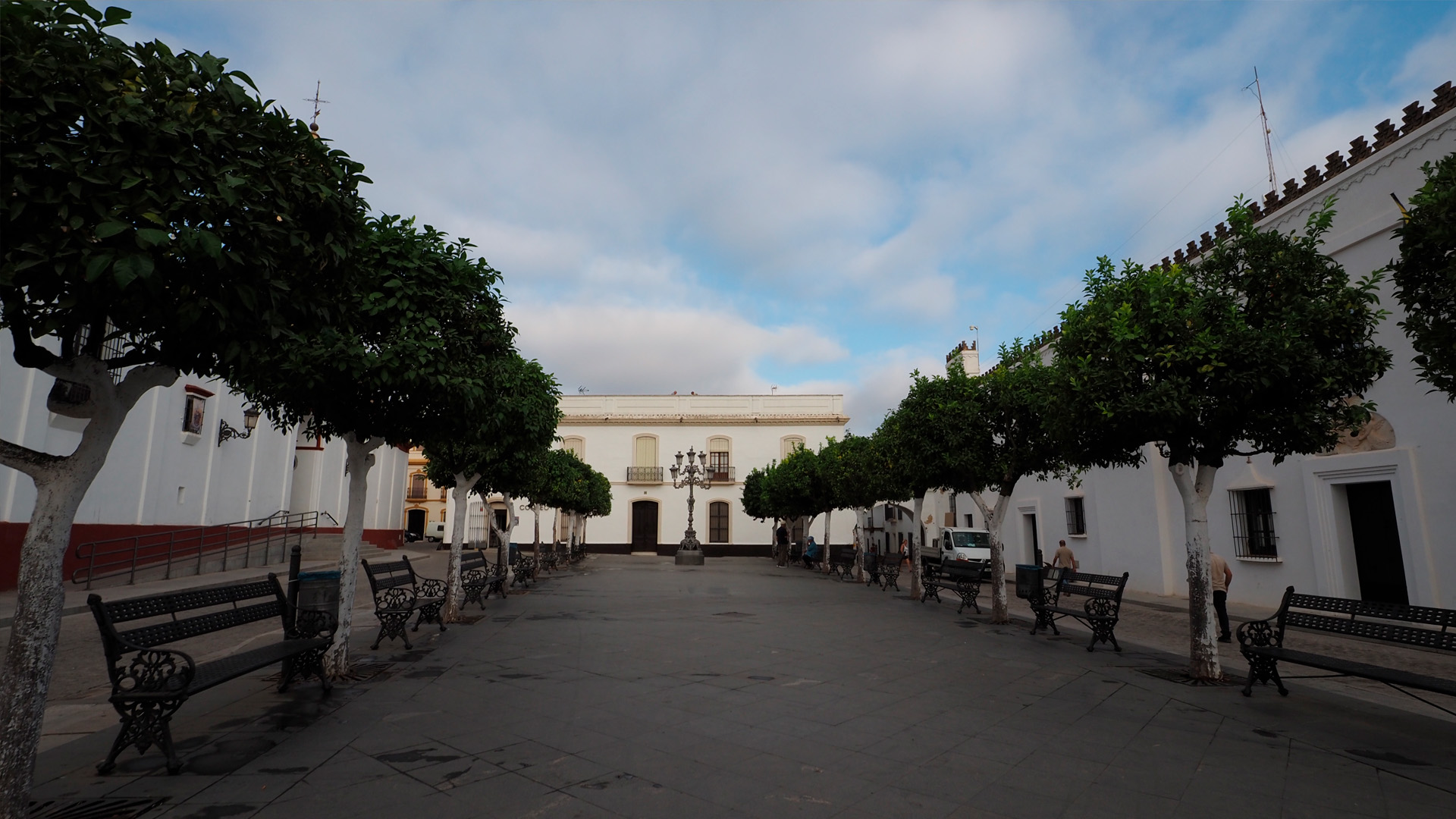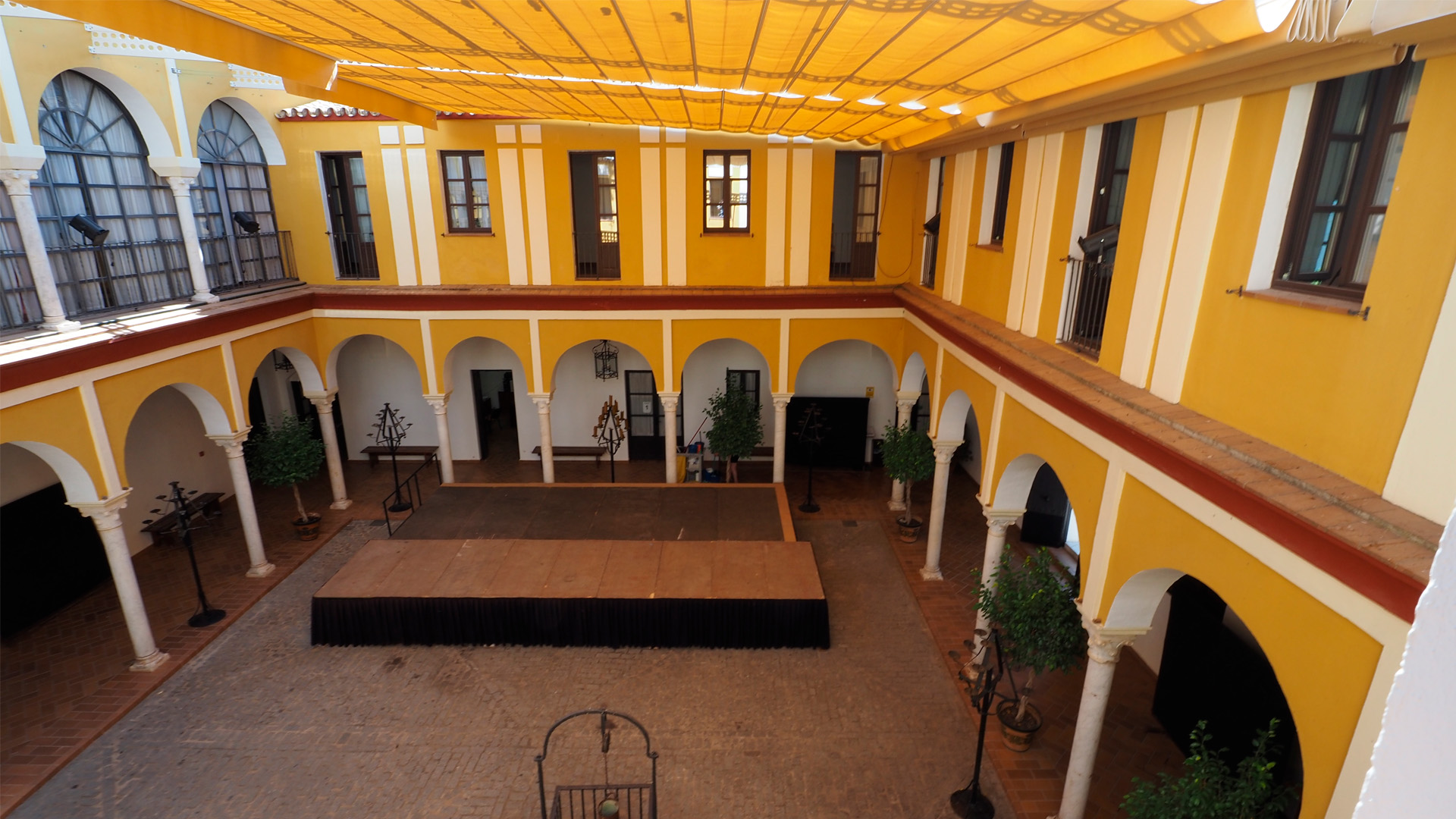We have prepared 3 virtual tours in anticipation of your visit.
Now you can visit the emblematic monuments of Olivares from your smartphone or PC. Just click on the button below to start your visit, see you inside!
Mira cómo se ven en 3D sus 3 referencias monumentales

The Plaza de España, which is currently the nerve centre of the town, was once the parade ground of the county palace. It is bounded by the buildings of the Collegiate Church, the Palace and the Granary or Alfolí, a building for the storage of grain erected between the 17th and 18th centuries, which conserves stylistic elements of the Baroque style on its façade.
The origins of the town of Olivares date back to Roman times, when, after the conquest of Baetica by a Roman soldier called Turculus, the land now occupied by the town was converted over time into a settlement known as Estercolines or Estercolinas.
Built in the second half of the 16th century by Don Pedro de Guzmán, 1st Count of Olivares, it was enriched in the 17th century by Don Gaspar de Guzmán y Pimentel, Count Duke of Olivares. Residence of the Counts of Olivares, it would later also be the residence of the abbots and canons of the Collegiate Church. In Renaissance style and symmetrical composition, it is flanked by two pointed arches crowned by battlements with bas-relief decorations. It also has four towers that slightly advance towards the square with pyramidal finials. The main doorway has slender half-columns of Genoese marble on a jamb, while the central doorway has the coat of arms of the Casa de los Guzmanes, in Genoese marble, which represents two harpies holding the coat of arms, topped by a winged dragon. Currently the seat of the Town Hall, it offers a permanent exhibition of handcrafted reproductions of Baroque period costumes.


The second Count of Olivares, Enrique de Guzmán y Ribera, was responsible for founding the Chapel of Olivares. Between 1582 and 1591, Don Enrique held one of the most important posts of his time, the Spanish embassy in Rome; he dealt with three pontiffs, Gregory XIII, Sixtus V and Gregory XIV, the first of whom approved the foundation of the Chapel of Olivares and the second of whom granted him important bulls that granted the Chapel notable privileges.
The third Count of Olivares, Gaspar de Guzmán y Pimentel, who has gone down in Spanish history for having been the favourite of King Philip IV on inheriting the House of Olivares, made clear his intention to raise the status of the chapel that had been founded by his father, and thus proposed the erection of the church as a collegiate church, a mercy he finally obtained from Pope Urbanc Vill by bull issued on 1 March 1623, although these bulls did not reach Spain until 1625.

Ruta Conde Duque Olivares 2022. Todos los derechos reservados © Nattule. Desarrollo web NattuAR.
We firmly believe that the internet should be available and accessible to anyone, and are committed to providing a website that is accessible to the widest possible audience, regardless of circumstance and ability.
To fulfill this, we aim to adhere as strictly as possible to the World Wide Web Consortium’s (W3C) Web Content Accessibility Guidelines 2.1 (WCAG 2.1) at the AA level. These guidelines explain how to make web content accessible to people with a wide array of disabilities. Complying with those guidelines helps us ensure that the website is accessible to all people: blind people, people with motor impairments, visual impairment, cognitive disabilities, and more.
This website utilizes various technologies that are meant to make it as accessible as possible at all times. We utilize an accessibility interface that allows persons with specific disabilities to adjust the website’s UI (user interface) and design it to their personal needs.
Additionally, the website utilizes an AI-based application that runs in the background and optimizes its accessibility level constantly. This application remediates the website’s HTML, adapts Its functionality and behavior for screen-readers used by the blind users, and for keyboard functions used by individuals with motor impairments.
If you’ve found a malfunction or have ideas for improvement, we’ll be happy to hear from you. You can reach out to the website’s operators by using the following email
Our website implements the ARIA attributes (Accessible Rich Internet Applications) technique, alongside various different behavioral changes, to ensure blind users visiting with screen-readers are able to read, comprehend, and enjoy the website’s functions. As soon as a user with a screen-reader enters your site, they immediately receive a prompt to enter the Screen-Reader Profile so they can browse and operate your site effectively. Here’s how our website covers some of the most important screen-reader requirements, alongside console screenshots of code examples:
Screen-reader optimization: we run a background process that learns the website’s components from top to bottom, to ensure ongoing compliance even when updating the website. In this process, we provide screen-readers with meaningful data using the ARIA set of attributes. For example, we provide accurate form labels; descriptions for actionable icons (social media icons, search icons, cart icons, etc.); validation guidance for form inputs; element roles such as buttons, menus, modal dialogues (popups), and others. Additionally, the background process scans all of the website’s images and provides an accurate and meaningful image-object-recognition-based description as an ALT (alternate text) tag for images that are not described. It will also extract texts that are embedded within the image, using an OCR (optical character recognition) technology. To turn on screen-reader adjustments at any time, users need only to press the Alt+1 keyboard combination. Screen-reader users also get automatic announcements to turn the Screen-reader mode on as soon as they enter the website.
These adjustments are compatible with all popular screen readers, including JAWS and NVDA.
Keyboard navigation optimization: The background process also adjusts the website’s HTML, and adds various behaviors using JavaScript code to make the website operable by the keyboard. This includes the ability to navigate the website using the Tab and Shift+Tab keys, operate dropdowns with the arrow keys, close them with Esc, trigger buttons and links using the Enter key, navigate between radio and checkbox elements using the arrow keys, and fill them in with the Spacebar or Enter key.Additionally, keyboard users will find quick-navigation and content-skip menus, available at any time by clicking Alt+1, or as the first elements of the site while navigating with the keyboard. The background process also handles triggered popups by moving the keyboard focus towards them as soon as they appear, and not allow the focus drift outside of it.
Users can also use shortcuts such as “M” (menus), “H” (headings), “F” (forms), “B” (buttons), and “G” (graphics) to jump to specific elements.
We aim to support the widest array of browsers and assistive technologies as possible, so our users can choose the best fitting tools for them, with as few limitations as possible. Therefore, we have worked very hard to be able to support all major systems that comprise over 95% of the user market share including Google Chrome, Mozilla Firefox, Apple Safari, Opera and Microsoft Edge, JAWS and NVDA (screen readers), both for Windows and for MAC users.
Despite our very best efforts to allow anybody to adjust the website to their needs, there may still be pages or sections that are not fully accessible, are in the process of becoming accessible, or are lacking an adequate technological solution to make them accessible. Still, we are continually improving our accessibility, adding, updating and improving its options and features, and developing and adopting new technologies. All this is meant to reach the optimal level of accessibility, following technological advancements. For any assistance, please reach out to